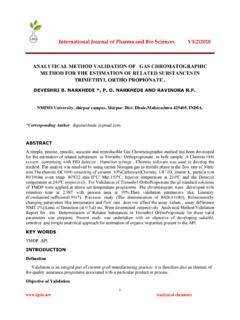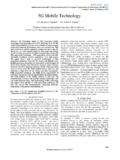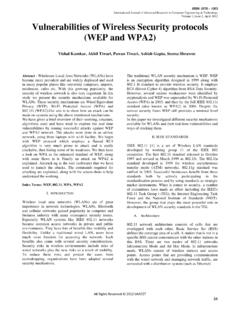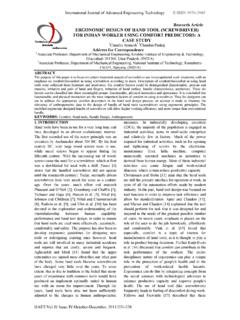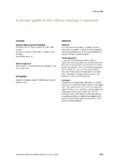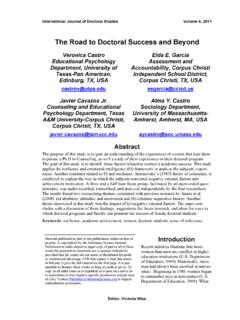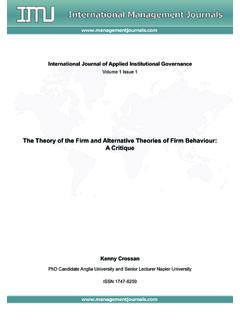Transcription of International Journal of Pharma and Bio Sciences
1 ISSN 0975-6299 Pharmaceutics 1 International Journal of Pharma and Bio Sciences TECHNOLOGY TRANSFER IN PHARMACEUTICAL INDUSTRY: A DISCUSSION AMANJEET SINGH* AND GEETA AGGARWAL Rayat Institute of Pharmacy, Railmajra, District Nagar, Punjab,India. *Corresponding Author ABSTRACT Technology transfer is both integral and critical to drug discovery and development process for new medicinal products. A major decision focuses on that point where the idea or process is advanced from a research- oriented program to targeted toward commercialization.
2 Generally the cost of product development rises dramatically during the pilot scale-up and initial production batch efforts. In other words, the critical path for success is dependent on completion of the technology transfer to the production site at an affordable cost. The success of any program is highly dependent on the effectiveness of the communication preceding its implementation. The ultimate goal for successful technology transfer is to have documented evidence that the manufacturing processes for drug substances and drug product, respectively, are robust and effective in producing the drug substances and drug product complying with the registered specifications and Good Manufacturing Practice requirements.
3 KEY WORDS Technology transfer, Technology transfer dossier, Scale up, Exhibit batch INTRODUCTION Technology transfer is the practice of transferring scientific findings from one organization to another for further development, So that new products such as medicines, educational tool, electronic devices, safety equipment and health services can become available to the public. Technology transfer is the intersection between business, science, engineering, law and government1-2. Technology transfer is both integral and critical to the drug discovery and development process for new medicinal product. This process is important for to elucidate necessary information for technology transfer from R & D (Research & Development) to PDL (product development laboratory) and for development of existing products to the production for commercialization.
4 Technology Transfer is helpful to develop dosage forms in various ways like it provides efficiency in process, helps to maintain quality of product, helps to achieve standardized process, which in turn facilitates timely & cost effective production3-4. Why technology transfer in pharmaceutical industry In the pharmaceutical industry technology transfer refers to the processes that are needed for successful progress from drug discovery to ISSN 0975-6299 Pharmaceutics 2 product development, to clinical trials to full scale commercialization or it is the process by which a developer of technology makes its technology available to commercial partner that will exploit technology.
5 In pharmaceutical industry preparation of dosage form needs scale up in/at several stages, such as small scale laboratory development from batch can be scaled up to 5-10 kg and then to 20-100 kg on a pilot scale. Production scale can typically range from 200 kg to greater than 1000 kg. Technology transfer involves manufacturing drug product with increasing batch sizes on larger equipment or using continous processing on pilot scale equipment. Generally scale up involves the transfer of technology and the transfer of knowledge that has been accumulated during the small scale development of product and processes.
6 It is important to realize that good communication is critical for formulation and process transfer to be successful. It is essential for a researcher or developer of technology to make available this technology to another person s to exploit for the progress of development of technology and for exploitation of a technology in different fields of applications and to make is use with another organization that may have better manufacturing capability, marketing capability and commercial capability. In the pharmaceutical industry, technology transfer by collaborating with other departments and other organizations to commercialize a pharmaceutical product is a common process5-7.
7 Steps in technology transfer Technology Transfer is not a single way process. Whether a tablet, a transdermal patch, a topical ointment, or an injectable, the transformation of a pharmaceutical prototype into a successful product requires the cooperation of many individuals. The classic view of a flow from basic to applied technology is a great oversimplification-sometimes, problems or insights arising at the production level give rise to new ideas that contribute to fundamental basic advance. At least in some sectors, close links between the basic researchers and manufacturing experts, and even marketing personnel contribute to competitiveness and advancement2, 6-7.
8 The development of new formulation goes through many stages as shown in figure. 1 ISSN 0975-6299 Pharmaceutics 3 During development of a formulation, it is important to understand procedure of operations used, critical and non-critical parameters of each operation, production environment, equipment and excipient availability, which should be taken into account during the early phases of development of formulation, so that successful scale up can be carried out.
9 Appropriate care during technology transfer is important to enhance drug quality as developed by R & D in final formulation as well as to assure quality for predetermined period of time. The various steps involved in technology transfer are given below: 1. Development of technology by R & D a. Design of procedure and selection of excipients by R & D: Selection of materials and design of procedures is developed by R & D on the basis of innovator product characteristics. For this different tests and compatibility studies are done. b. Identification of specification and quality by R & D: Generally it should be considered by R & D that quality of product should meet the specifications of an innovator product.
10 For this different stability studies are carried out for innovator product and for product which is to be manufactured. 2. Technology transfer from R & D to production: R & D provides technology transfer dossier (TTD) document to product development laboratory, which contains all information of formulation and drug product as given below: a. Master formula card (MFC) includes product name along with its strength, generic name, MFC number, page number, effective date, shelf life and market. b. Master packaging card gives information about packaging type, material used for packaging, stability profile of packaging and shelf life of packaging.

